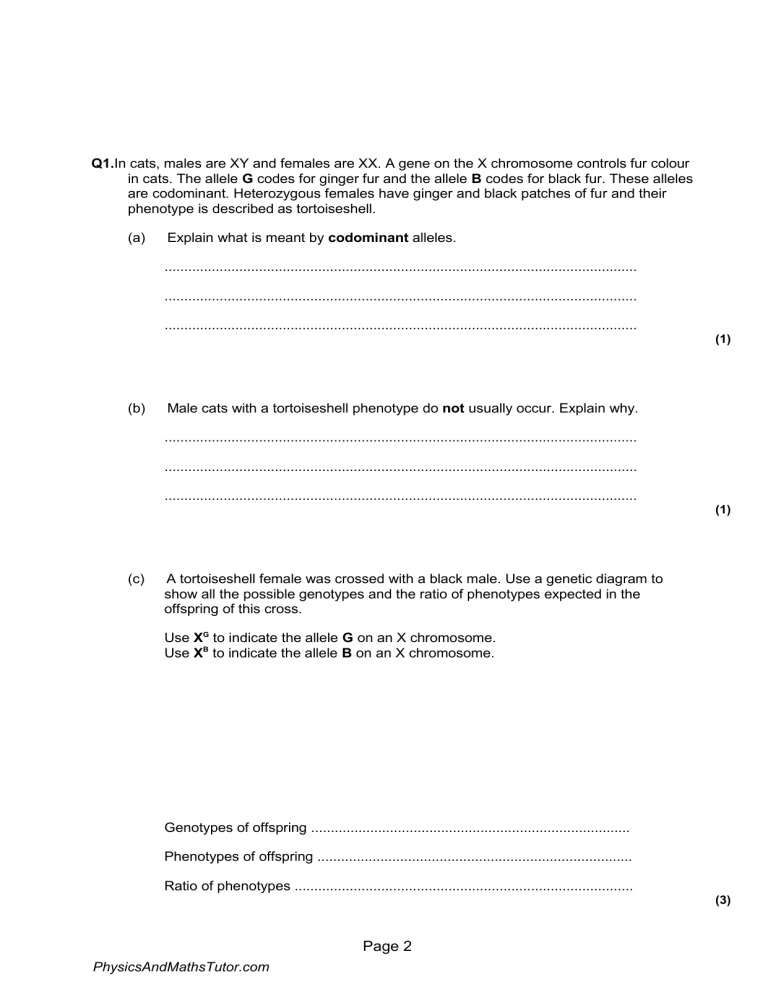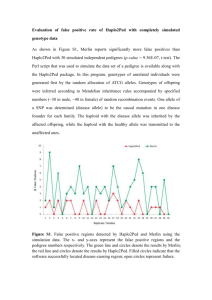
Q1.In cats, males are XY and females are XX. A gene on the X chromosome controls fur colour in cats. The allele G codes for ginger fur and the allele B codes for black fur. These alleles are codominant. Heterozygous females have ginger and black patches of fur and their phenotype is described as tortoiseshell. (a) Explain what is meant by codominant alleles. ........................................................................................................................ ........................................................................................................................ ........................................................................................................................ (1) (b) Male cats with a tortoiseshell phenotype do not usually occur. Explain why. ........................................................................................................................ ........................................................................................................................ ........................................................................................................................ (1) (c) A tortoiseshell female was crossed with a black male. Use a genetic diagram to show all the possible genotypes and the ratio of phenotypes expected in the offspring of this cross. Use XG to indicate the allele G on an X chromosome. Use XB to indicate the allele B on an X chromosome. Genotypes of offspring ................................................................................. Phenotypes of offspring ................................................................................ Ratio of phenotypes ...................................................................................... (3) Page 2 PhysicsAndMathsTutor.com (d) Polydactyly in cats is an inherited condition in which cats have extra toes. The allele for polydactyly is dominant. (i) In a population, 19% of cats had extra toes. Use the Hardy-Weinberg equation to calculate the frequency of the recessive allele for this gene in this population. Show your working. Answer = ............................ (2) (ii) Some cat breeders select for polydactyly. Describe how this would affect the frequencies of the homozygous genotypes for this gene in their breeding populations over time. ............................................................................................................... ............................................................................................................... ............................................................................................................... ............................................................................................................... (1) (Total 8 marks) Q2.Some populations of flies are becoming resistant to insecticides intended to kill them. Scientists developed a method for finding out whether a fly was carrying a recessive allele, r, that gives resistance to an insecticide. The dominant allele, R, of this gene does not give resistance. The scientists: • crossed flies with genotype RR with flies with genotype rr • obtained DNA samples from the parents and offspring • used the same restriction endonuclease enzymes on each sample, to obtain DNA Page 3 PhysicsAndMathsTutor.com fragments. (a) Explain why the scientists used the same restriction endonuclease enzymes on each DNA sample. ........................................................................................................................ ........................................................................................................................ ........................................................................................................................ ........................................................................................................................ (2) The scientists added two different primers to each sample of DNA fragments for the polymerase chain reaction (PCR). • • Primer A3 only binds to a 195 base-pair fragment from allele r. Primer A4 only binds to a 135 base-pair fragment from allele R. The scientists separated the DNA fragments produced by the PCR on a gel where shorter fragments move further in a given time. Their results are shown in Figure 1. Figure 1 (b) Explain why primer A3 and primer A4 only bind to specific DNA fragments. ........................................................................................................................ ........................................................................................................................ ........................................................................................................................ ........................................................................................................................ (2) Page 4 PhysicsAndMathsTutor.com (c) Use all the information given to explain the results in Figure 1. ........................................................................................................................ ........................................................................................................................ ........................................................................................................................ ........................................................................................................................ ........................................................................................................................ ........................................................................................................................ [Extra space] ................................................................................................ ........................................................................................................................ ........................................................................................................................ (3) (d) The scientists wanted to know on which chromosome the gene with alleles R and r was located. From the flies with genotype RR, they obtained cells that were in mitosis and added a labelled DNA probe specific for allele R. They then looked at the cells under an optical microscope. Explain why they used cells that were in mitosis. ........................................................................................................................ ........................................................................................................................ ........................................................................................................................ ........................................................................................................................ (2) (e) Another group of scientists thought that pesticide resistance in some flies was related to increased activity of an enzyme called P450 monooxygenase (PM). This enzyme breaks down insecticides. The scientists obtained large numbers of resistant and non-resistant flies. They then set up the following experiments. • • Non-resistant flies exposed to insecticide. Resistant flies exposed to insecticide. Page 5 PhysicsAndMathsTutor.com • Resistant flies treated with an inhibitor of PM and then exposed to insecticide. They then determined the percentage of flies that were dead at different times after being exposed to insecticide. Figure 2 shows their results. Figure 2 (i) Explain why the scientists carried out the control experiment with the non-resistant flies. ............................................................................................................... ............................................................................................................... ............................................................................................................... ............................................................................................................... ............................................................................................................... (2) (ii) The scientists concluded that the resistance of the flies to the insecticide is partly due to increased activity of PM but other factors are also involved. Explain how these data support this conclusion. ............................................................................................................... ............................................................................................................... ............................................................................................................... Page 6 PhysicsAndMathsTutor.com ............................................................................................................... ............................................................................................................... ............................................................................................................... [Extra space] ....................................................................................... ............................................................................................................... ............................................................................................................... ............................................................................................................... (4) (Total 15 marks) Q3.(a) In fruit flies, the genes for body colour and wing length are linked. Explain what this means. ........................................................................................................................ ........................................................................................................................ (1) A scientist investigated linkage between the genes for body colour and wing length. He carried out crosses between fruit flies with grey bodies and long wings and fruit flies with black bodies and short wings. Figure 1 shows his crosses and the results. • • G represents the dominant allele for grey body and g represents the recessive allele for black body. N represents the dominant allele for long wings and n represents the recessive allele for short wings. Figure 1 grey body, long wings Phenotype of parents GGNN Genotype of parents ggnn GgNn Genotype of offspring Page 7 PhysicsAndMathsTutor.com × black body, short wings all grey body, long wings Phenotype of offspring These offspring were crossed with flies homozygous for black body and short wings. The scientist’s results are shown in Figure 2. Figure 2 GgNn crossed with ggnn Grey body, Black body, Grey body, Black body, long wings short wings short wings long wings Number of offspring (b) 975 963 186 194 Use your knowledge of gene linkage to explain these results. ........................................................................................................................ ........................................................................................................................ ........................................................................................................................ ........................................................................................................................ ........................................................................................................................ ........................................................................................................................ ........................................................................................................................ ........................................................................................................................ (Extra space) ................................................................................................ ........................................................................................................................ ........................................................................................................................ ........................................................................................................................ ........................................................................................................................ (4) (c) If these genes were not linked, what ratio of phenotypes would the scientist have expected to obtain in the offspring? Page 8 PhysicsAndMathsTutor.com ........................................................................................................................ ........................................................................................................................ (1) (d) Which statistical test could the scientist use to determine whether his observed results were significantly different from the expected results? Give the reason for your choice of statistical test. ........................................................................................................................ ........................................................................................................................ ........................................................................................................................ ........................................................................................................................ (2) (Total 8 marks) Q4.In birds, males are XX and females are XY. (a) Use this information to explain why recessive, sex-linked characteristics are more common in female birds than in male birds. ........................................................................................................................ ........................................................................................................................ (1) (b) In chickens, a gene on the X chromosome controls the rate of feather production. The allele for slow feather production, F, is dominant to the allele for rapid feather production, f. The following figure shows the results produced from crosses carried out by a farmer. Page 9 PhysicsAndMathsTutor.com (i) Explain one piece of evidence from the figure which shows that the allele for rapid feather production is recessive. ............................................................................................................... ............................................................................................................... ............................................................................................................... ............................................................................................................... (2) (ii) Give all the possible genotypes of the following chickens from the figure. Chicken 5 .............................................................................................. Chicken 7 .............................................................................................. (2) (iii) A cross between two chickens produced four offspring. Two of these were males with rapid feather production and two were females with slow feather production. Give the genotypes of the parents. ............................................................................................................... Page 10 PhysicsAndMathsTutor.com (1) (c) Feather colour in one species of chicken is controlled by a pair of codominant alleles which are not sex-linked. The allele CB codes for black feathers and the allele CW codes for white feathers. Heterozygous chickens are blue-feathered. On a farm, 4% of the chickens were black-feathered. Use the Hardy-Weinberg equation to calculate the percentage of this population that you would expect to be blue-feathered. Show your working. Answer ...................................... % (3) (Total 9 marks) Page 11 PhysicsAndMathsTutor.com


